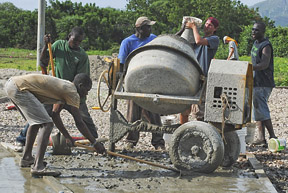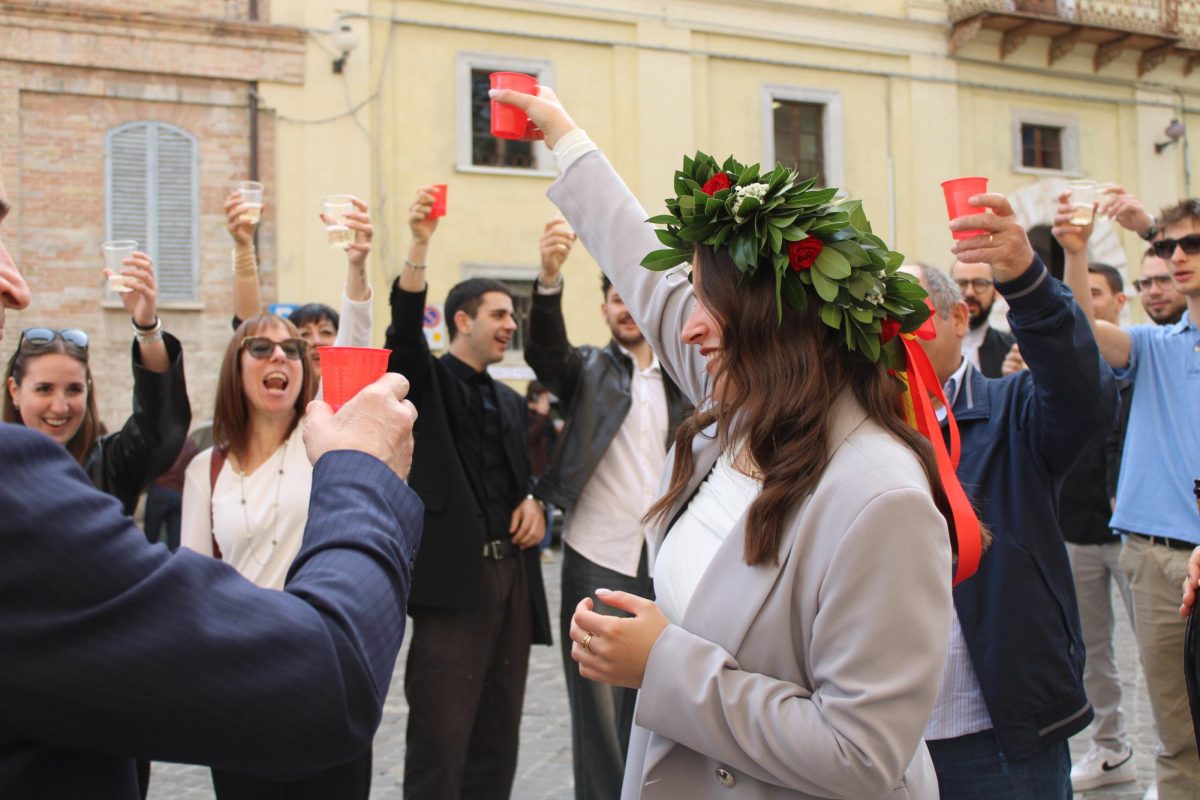Iowa State architecture students incorporate Haitian culture into design

Volunteers work with the head concrete team in the village to finish pouring the basketball court.
September 26, 2010
Being in Haiti was a little out of the Design Across Boundaries members’ comfort zone — especially after its earthquake.
“To see it on news and to drive through the capital, Port-au-Prince, which was all shaken to the ground, to see the women and the youth exploit themselves in the tent cities in order to earn enough to feed themselves for the day, definitely was an experience that required us to step outside of our comfort zone and accept reality,” said Jasmine Singh, member of DAB and senior in architecture. “I remember feeling short of words for a conversation on our drive back from witnessing 150,000 tents where refugees from the earthquake were relocated, initially with aid, now with none.”
But the nonprofit group was there for a purpose — to create a community center for La Croix.
“But going to La Croix and watching the community prosper was a beautiful surprise,” Singh said. “Working on-site with the children, walking through the community houses, hearing them sing in their classrooms, playing hand games with them and lastly, attending church on Sunday, where we introduced the project — that was undoubtedly the most overwhelming few hours, to hug almost every member, overwhelmed at our vision for them.”
Many in DAB agree that having the opportunity to go to Haiti and meet the people they would be working to benefit was the most enjoyable part of the design process, while being incredibly eye-opening at the same time.
Though the idea of going to another country and trying to implement an idea into a community that might not be accepting of it was nerve-wrecking for the entire group, things turned out well.
“They welcomed us with open arms and appreciated all the work we are doing for them; they have little now, so everything that comes into their lives, they embrace,” said Jason Kruse, DAB member and senior in architecture.
While at the mission in La Croix, in addition to getting to know the people they were designing this community center for, members got the chance to work on the soccer field and basketball court, which the Salt Company group had nearly completed during Spring Break.
This was also a unique opportunity for them as architecture students, being as they typically work with the aesthetic side of design, and this project and trip gave them first-hand experience on the mechanical systems learning side of architecture, which is extremely valuable.
They all quickly realized it is quite hard to design for a place you’ve never been to.
“Going to Haiti opened our eyes both on what we were designing for, but also the severity and need of what we were designing,” said DAB member Michael Vander Ploeg and senior in architecture.
“The problems that we were presented became much more apparent, and some problems we were not presented became apparent after our trip,” Vander Ploeg said. “To be honest, we had no idea what we were designing, who we were designing for or why we were doing it, until we actually went to Haiti.”
On the second day at the mission, they presented to Altinor, the school superintendent and a community leader.
“What immediately drew him into our conversation was that we mentioned we were there to learn how to incorporate the culture of La Croix into our design,” said Kristen O’Brien, DAB member and senior in architecture.
“He said this project will put value into the children and encourage them to not only excel in soccer, but also in music and academics,” Singh said.
They also presented their idea to a handful of other community leaders of the mission and school.
“Their response was gratitude and excitement,” said Scott Mead, DAB member and senior in architecture. “They were humbled and we were humbled.”
However, many of them made comments on how much they loved the project except they had no money to give to it, but they could give DAB their “full support and confidence,” O’Brien said.
“That is really what has allowed us to continue designing now that we are back from Haiti. Without their support, we would be back at square one,” O’Brien said.
“It excited them to know we would strongly consider the culture of Haiti while we designed for them,” Mead said. “When we came back from our trip to Haiti, this idea of preservation of the Haitian culture became more of a reality. We could finally begin to understand the lifestyle and values of the people in La Croix, and that is the most important thing to consider when designing for these people.”
The HOTH mission itself has funds to help with projects like this, but DAB has also been doing a lot of fundraising to offset the costs. So although the community members could not help with any of the funding to support this project, they were more than willing to help in many other ways.
“They were eager to help with anything they could get their hands on —pulling weeds, digging holes, hauling rocks and sand — anything to ‘earn’ this community center,” Vander Ploeg said.
“The Haitian people are gracious and proud. They are truly an amazing group of people to design for,” Mead said. “While they have so much ability and knowledge, they just do not always have the resources to complete their daring visions.”
DAB was also given the opportunity to present its design to a larger part of the community during a Sunday morning church service.
“The community was more thankful and appreciative than we could have imagined,” Mead said. “They wrote notes of gratitude and joy in Creole, the native language, on a paper-covered wall. This was when we knew we had to build this thing. Nothing will come in our way from now on. These people deserve it.”
DAB hopes that by using its new ideas with shipping containers mixed in with traditional building techniques, such as the concrete blocks, the people of La Croix will be able to think about change and take ownership in the project.
“If they see how simple ideas can significantly change the condition of the world around them, we hope that they will feel empowered to make smaller changes within their own lives to better their situation,” O’Brien said.
After having spent a week in Haiti, the members of DAB agree that the vision of Silentor Esthil-Henderson, Haitian native and recent graduate of Iowa State that coordinates the HOPE mission who opened the door to follow through with this project, became much more clear.
“Working with Silentor was an amazing experience. We learned after our trip that Silentor has essentially fulfilled what this town set out to do: Educate their young ones so that they can return to La Croix to better the community and the future of the town,” Vander Ploeg said.
DAB members thoroughly took advantage of their opportunity to travel to Haiti and, though skeptical at first, are really making things happen.
“To go into their world and present our ideas and visions was not an easy task,” Mead said. “We were afraid, in a sense. We were afraid the people would not accept our ideas and design, as we had little knowledge of the culture prior to the trip.
“This assumption was wrong, and two different groups of people and cultures were able to come together to become excited for the potential of the future.”
















